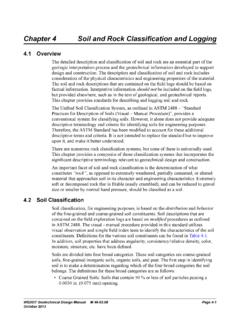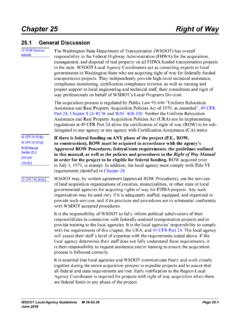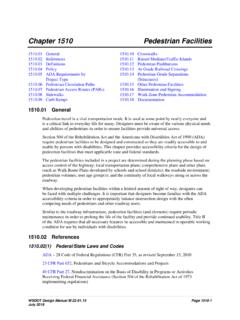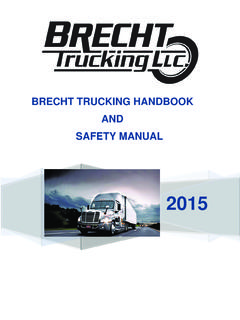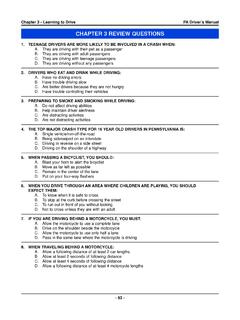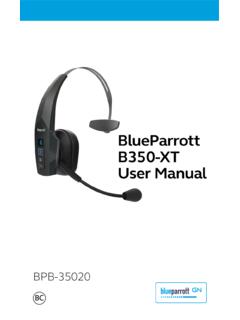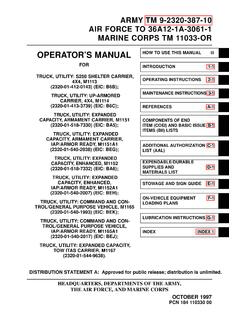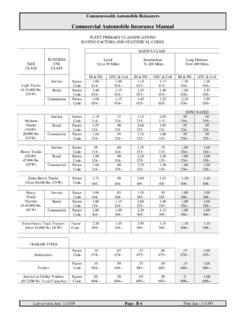Transcription of Chapter 13 Bridge Load Rating Contents
1 WSDOT Bridge Design Manual M Page 13-i July 2019 Chapter 13 Bridge load Rating LRFR Method per the load Factor Method (LFR) .. Allowable Stress Method (ASD) .. Live Rating Trucks .. Special Rating Criteria .. Dead Live load Distribution Reinforced Concrete Structures .. Prestressed Concrete Structures .. Concrete Concrete In-Span Girder Box Girder Segmental Concrete Concrete Slab Steel Steel Floor Steel Truss Timber Structures .. Widened or Rehabilitated load Rating Software .. load Rating Appendices ..13-17 Appendix LFR Bridge Rating LRFR Bridge Rating Summary .. 13 Bridge load RatingPage 13-ii WSDOT Bridge Design Manual M July 2019 WSDOT Bridge Design Manual M Page 13-1 July 2019 Chapter 13 Bridge load GeneralBridge load Rating is a procedure to evaluate the adequacy of various structural components to carry predetermined live loads.
2 The Bridge load Rating Engineer in the WSDOT Bridge Preservation Office is responsible for the Bridge inventory and load Rating of existing and new bridges in accordance with the National Bridge Inspection standards (NBIS) and the AASHTO Manual for Bridge Evaluation (MBE), latest edition. Currently, only elements of the superstructure will be rated, however, if conditions warrant, substructure elements may need to be rated. The superstructure shall be defined as all structural elements above the column tops including drop ratings are required for all new, widened, or rehabilitated bridges where the rehabilitation alters the load carrying capacity of the structure. load ratings shall be done immediately after the design is completed and Rating calculations shall be filed separately per Section and files shall be forwarded to WSDOT s load Rating Bridge Preservation Office is responsible for maintaining an updated Bridge load Rating throughout the life of the Bridge based on the current condition of the Bridge .
3 Conditions of existing bridges change over time, resulting in the need for reevaluation of the load Rating . Such changes may be caused by damage to structural elements, extensive maintenance or rehabilitative work, or any other deterioration identified by the Bridge Preservation Office through their regular inspection bridges that have designs completed after October 1, 2010 shall be rated based on the load and Resistance Factor Rating (LRFR) method per the MBE and this Chapter . NBI ratings shall be based on the HL-93 truck and shall be reported as a Rating factor. For bridges designed prior to October 1, 2010, partially reconstructed or rehabilitated bridges where part of the existing structure is designed by the Allowable Stress Method (ASR) or by the load Factor Method (LFR), and other existing structures, NBI ratings can be based on either the LFR or load Resistance Factor Rating (LRFR) methods.
4 The Rating factors shall be based on HS loading and reported in tons when using the LFR method. For State owned structures, verify with WSDOT s load Rating Engineer regarding which load Rating method to use for bridges designed prior to October 1, 2010. By definition, the adequacy or inadequacy of a structural element to carry a specified truck load will be indicated by the value of its Rating factor (RF); that is, whether it is greater or smaller than 13 Bridge load RatingPage 13-2 WSDOT Bridge Design Manual M July LRFR Method per the MBER ating 1 2 ( )Where:RF = Rating factorC = c s n Rn, where c s for strength limit stateC = fR for service limit stateRn = Nominal Capacity of member R = Allowable Stress per LRFDDC = Dead load due to structural components and attachmentsDW = Dead load due to wearing surface and utilitiesP = Permanent loads other than dead loadsLL = Live load effectIM = Dynamic load allowance (Impact)* DC = Dead load factor for structural components and attachments DW = Dead load factor for wearing surface (ACP/HMA)
5 And utilities P = load factor for permanent load LL = Live load factor c = Condition factor s = System factor n = Resistance factor based on construction material* for concrete overlays use DC When Rating the full section of a Bridge , like a box girder or 3D truss, or crossbeams, with two or more lanes, the following formula applies when Rating emergency vehicles and overload =$% ' ()* +%' (), +- (/ 01(22 33 (5678) =:';<=>:';<?>@ ;AB;CC(DD6 DDEFE) (56GH) =I%'()2 + J(22 33 (5678) =MN(5OM63) =:';<C> P;CC(DD6 DDEFE )(56GH) = QRST' $UV6U/6UW1UX (5678) = ' $UV6U/6UW1UX (5678) =N.[NRST'5O\ $UV6U/6UW1UX (5678) =N.]NR^ ' $UV6U/6UW1UX (5678) =N.`NR^ ' $UV6U/6UW1UX (5678) =Ua'UVUX ( ) The formula above assumes that there is one overload truck occupying one lane, and one of the legal trucks occupying each of the remaining lanes.)))
6 Trucks shall be placed in the lanes in a manner that produces the maximum forces. The live load factor for both of the legal truck and permit truck shall be equal and are dependent on the permit truck . The LLlgl shown in the equation above corresponds to the maximum effect of the legal truck (s).Condition Factor ( cc) Condition factor is based on the Bridge Management System (BMS) condition state of the element per the most recent inspection report. The engineer should consider the quantity of each element in a fair or poor condition state and the notes describing the condition of an element when determining the appropriate condition Condition of Member cGood or Satisfactory, BMS Condition 1 or , BMS Condition , BMS Condition load Rating Chapter 13 WSDOT Bridge Design Manual M Page 13-3 July 2019 System Factor ( s) The system factor shown in the table below applies to flexure and all axial forces.
7 Use a system factor of when Rating Structure Type sWelded Members in Two Girder/Truss/Arch Members in Two Girder/Truss/Arch Eyebar Members in Truss Bridges with Girder Spacing 6 Girder Bridges with Girder Spacing 4 Other Girder and Slab with Spacing >12 and Noncontinuous Stringer Subsystems Between Beams with a one or two columns, and Live load FactorsInventory HL-93 Operating HL-93 Legal & NRL LoadsPermit & EV* Bridge TypeLimit State DC DW pReinforced ConcreteStrength --Strength ConcreteStrength Table Strength For prestressed concrete elements, the Service III Rating for Legal Loads, and Service I Rating for permit loads are optional per the MBE. Service ratings can be ignored at the discretion of the load Rating Engineer if the structural elements being rated show no evidence of distress/cracking.
8 Girders that have high load hits shall be rated for load Factors for Legal and Permit LoadsTable load Factor ADTT 1000 ADTT > 1000 ADTT UnknownLegal & NRL * *Emergency Vehicle In cases where RF for legal loads is less than 1, which would require the Bridge to be posted, live load factors may be reduced (interpolated based on ADTT), per Section of the 13 Bridge load RatingPage 13-4 WSDOT Bridge Design Manual M July 2019 Number of LanesMultiple Presence Factor1 Lane= Lanes= Lanes= > 3 Lanes= The table above shows the Multiple Presence Factors based on the number of loaded lanes. For cases where a permit truck or an emergency vehicle is combined with legal trucks, the multiple presence factor for the total number of loaded lanes in each case shall be applied to all loads.
9 For cases where a permit truck is loaded in a single lane with no other trucks present, the multiple presence factor for 1 lane does not apply. If the Live load distribution factor for single lane based on the Lever Rule controls, the multiple presence factor for 1 lane isn t applicable. Dynamic load Allowance (Impact) Dynamic load allowance is dependent on the approach onto the Bridge and condition of the deck and joints based on the latest inspection Element 7681 BMS Flag 322HL 93 (All Span Lengths):Inventory33%N/AN/AOperating33%N /AN/ALegal, Permit Trucks & Emergency Vehicles: Spans 40 or less33%N/AN/ALegal, Permit Trucks & Emergency Vehicles Spans greater than 40 :Smooth Riding Surface Along Approach onto the Bridge , Bridge Deck and Expansion Joints10%81, 2 or noneMinor Surface Deviations and Depressions20%63 Severe Impact to the Bridge30%34 Verify the conditions of the deck and joints to identify any deficiencies in the deck that would cause impact to the structure.
10 For potholes less than 1 deep use 20 percent impact, and use 30 percent impact for depths greater than 1 . For multi span bridges, take into consideration the type and location of the deficiency and whether Impact would be applicable to the entire structure or not. If the Inspection report has no NBI Code 7681 or BMS Flag 322, then assume Smooth Loads The moving loads shall be the HL-93 loading, the AASHTO legal loads (including three AASHTO trucks and lanes where applicable and notional Rating load ), the two WSDOT overload vehicles (See Figures and thru ) and the two Emergency Vehicles (See Figures & ). Inventory and operating ratings shall be calculated for the HL-93 truck . In cases where the Rating factor for the Notational Rating load (NRL) is below , then the single unit vehicles (SUV) shall be evaluated for posting, see MBE for SUV load Rating Chapter 13 WSDOT Bridge Design Manual M Page 13-5 July load Factor Method (LFR)The load factor method can be applied to structures designed prior to October 2010.






